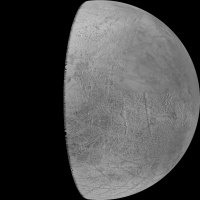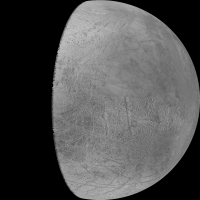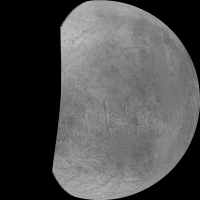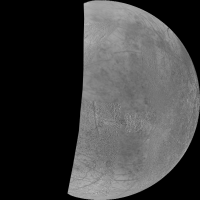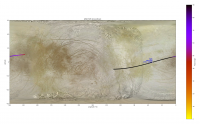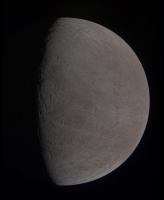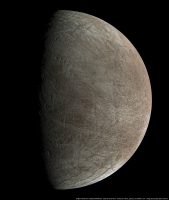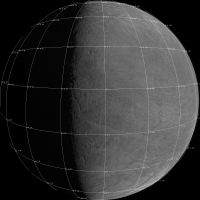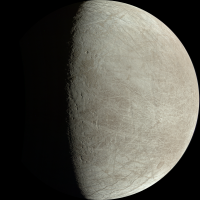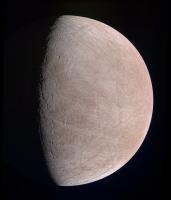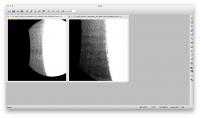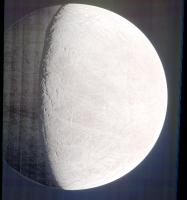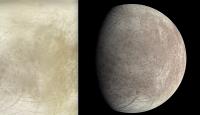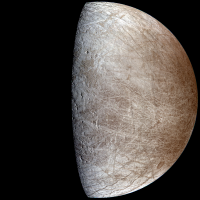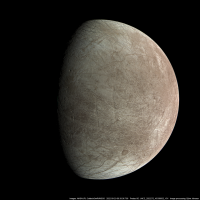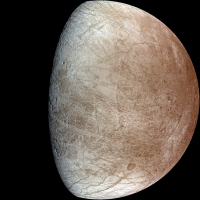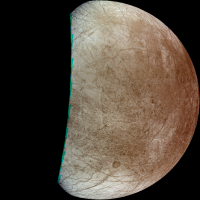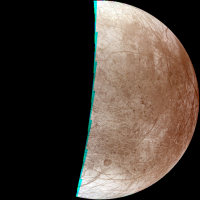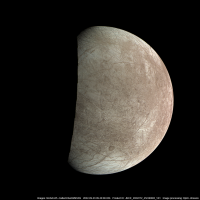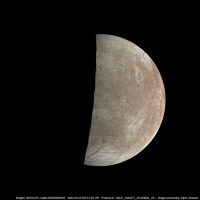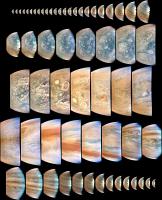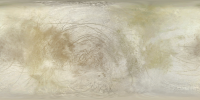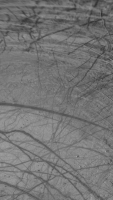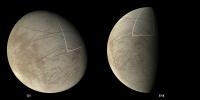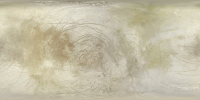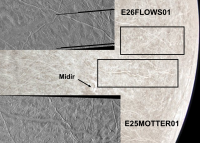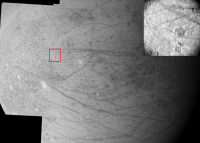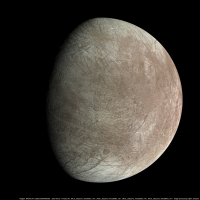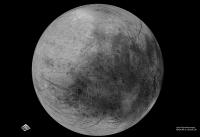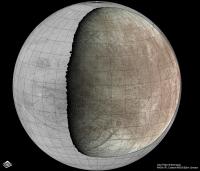Printable Version of Topic
Click here to view this topic in its original format
Unmanned Spaceflight.com _ Juno _ Europa Flyby - PJ45
Posted by: Decepticon Sep 13 2022, 02:58 AM
Juno is set to flyby of Europa on Sept. 29, 2022 (PJ45)
I can't wait to see the results of this flyby!
Sadly not much information is available online.
Jason Has a beautiful animation of encounter on youtube.
https://www.youtube.com/watch?v=r9bx1GcoqEE&t=40s&ab_channel=volcanopele
Posted by: mcaplinger Sep 13 2022, 11:36 PM
Junocam will take four RGB images on one-minute intervals starting at around terminator crossing (roughly 09:37:30 UT), using the same method used for the Ganymede imaging last year. I'm not sure when we can expect the data to show up, hopefully before that weekend but no guarantees.
Posted by: volcanopele Sep 14 2022, 04:02 AM
Thanks for that bit of info! In the morning I’ll make a set of preview images. I made one that I posted on Twitter but I think that was for the opportunity after the one you mentioned.
Posted by: StargazeInWonder Sep 14 2022, 07:02 AM
It seems, from the blurry quality of the base map in the upper right of the preview image, that there's reason to expect that this image may be an upgrade on the best coverage we have of that part of Europa. That would be great.
Posted by: mcaplinger Sep 14 2022, 03:58 PM
Probably. USGS coverage maps claim 6 km/pix over that area and we should get 2-4 km/pix. But we've found that the coverage maps are often optimistic about resolution, as some of it is motion-blurred or otherwise not great. On the other hand, it's a fast flyby and I don't want to overpromise anything.
Posted by: vjkane Sep 14 2022, 04:19 PM
6 m/pix is several order of magnitude better than 2-4 cm/pix. Is the first number or scale misstated?
Posted by: mcaplinger Sep 14 2022, 04:35 PM
Sorry, yes, obviously, I meant km/pix. Edited.
Posted by: vjkane Sep 14 2022, 05:01 PM
Do that all the time myself.
Looking forward to this flyby. Will be especially interested in what the microwave radiometer finds about the ice shell structure, but expect that will have to await publication of a peer-reviewed paper unlike the raw images.
Out of curiousity, I presume that the microwave radiometer is a passive instrument - is this correct?
Posted by: mcaplinger Sep 14 2022, 05:13 PM
Correct. Strictly speaking, there's no such thing as an active radiometer. Anything that has active and radiometer in the name is probably some kind of hybrid radar/radiometer, but MWR is not that, it's receive-only.
https://dataverse.jpl.nasa.gov/file.xhtml?fileId=50941&version=1.0 is sort of old, but the full Springer paper is paywalled, alas.
Posted by: StargazeInWonder Sep 14 2022, 07:50 PM
Some write-ups of Juno's microwave radiometer observations of Ganymede have recently been published, about a year after the flyby, and should give a rough idea of what capabilities it has regarding Europa.
https://meetingorganizer.copernicus.org/EGU22/EGU22-10748.html
Posted by: volcanopele Sep 14 2022, 07:50 PM
One thing to keep in mind for everyone is that Artemis is playing havoc on the DSN schedule for a lot of missions. The first launch opportunity is on the 27th and if that is a go and succeeds, there be might some impact on the schedule for later that week. So if images show up later than everyone expects compared to previous perijoves, that could be why.
Posted by: StargazeInWonder Sep 14 2022, 09:32 PM
DART will reach its destination on September 26. It's going to be a big week.
Posted by: volcanopele Sep 14 2022, 10:53 PM
Going with Mike's first image time, here are preview versions of each JunoCAM image:
Posted by: vjkane Sep 14 2022, 11:47 PM
Thanks. The depths of measurements in Europa's ice shell from a presentation about a year ago made me wonder if the instrument did have an additional active mode.
Posted by: mcaplinger Sep 14 2022, 11:52 PM
Nice, but my sims show Europa not leaving the FOV so quickly. Are you using a C kernel like juno_sc_prl_220928_221105_jm0450a_v01? There's a 4.5 degree offset from grav orientation for this pass.
Posted by: volcanopele Sep 15 2022, 02:24 AM
I updated my kernels earlier this week to prep for this week’s PDS release (not expecting JIRAM Io data, but there could be some distant ones) and for the Europa encounter. so yeah, that’s the kernel I’m using (along with the latest Predict trajectory file) to estimate the viewing geometry. I’m using Cosmographia to get a predicted central image time centered at Europa then I feed that time to a python script that spits out the center lat/Lon, subsolar lat/Lon, altitude, JIRAM pixel scale, and JunoCAM pixel scale.
Central image times were 09:37:49, 09:38:49, 09:39:49, and 09:40:48.
Posted by: djellison Sep 15 2022, 03:09 AM
Seriously - much kudos to DSN schedulers across every mission out there - between the Artemis requirements and the blunderbuss of CubeSats it's deploying - the impact to the DSN is like nothing I've ever seen.
Posted by: volcanopele Sep 15 2022, 03:55 AM
And I just so happen to be planning the images on TWO Mars cameras for that week… yeah.
Posted by: volcanopele Sep 21 2022, 11:46 PM
Back to Europa, I finally uploaded a preview video for the Europa encounter:
https://youtu.be/XZ040wMRSUA
Here is a ground track map for the encounter:
Posted by: Decepticon Sep 24 2022, 05:19 AM
https://www.jpl.nasa.gov/news/nasas-juno-will-perform-close-flyby-of-jupiters-icy-moon-europa
Posted by: Brian Swift Sep 27 2022, 07:26 AM
Noticed DSN has been chatting with Juno most of today. I wonder if that is typical 2 days before encounter.
Posted by: mcaplinger Sep 27 2022, 03:31 PM
Since the Europa flyby is a gravity assist for period reduction, there is probably more interest in radiometric tracking than there would be for a normal PJ. Though I can't say that this is atypical, I haven't looked before.
Posted by: mcaplinger Sep 29 2022, 06:16 PM
Europa images on missionjuno.
Posted by: Brian Swift Sep 29 2022, 06:41 PM
My Preliminary processing of PJ45_01. (51% chance it's upside down).
Posted by: volcanopele Sep 29 2022, 06:49 PM
Processing them now. I also have HiRISE commanding to do today. so this... this is going to be a long day...
Posted by: volcanopele Sep 29 2022, 07:05 PM
Knocking on all the wood here but I should have a controlled mosaic in the next hour.
Posted by: Bjorn Jonsson Sep 29 2022, 07:06 PM
This is a very early and preliminary version of the first image. North is up.
Posted by: mcaplinger Sep 29 2022, 07:08 PM
Looks right to me.
Posted by: Bjorn Jonsson Sep 29 2022, 07:18 PM
There seem to be far smaller errors in the spacecraft's position from the SPK predict kernel than there were for the Ganymede flyby. There I had to make large corrections but early indications are that I need to make only minor corrections here (it's even possible that I do not need to make any corrections to the spacecraft's position).
Posted by: Brian Swift Sep 29 2022, 07:32 PM
There was enough Jupiter-shine to bring the signal from night side up a little bit over noise levels.
Mike, since this is image number 01, I assume there isn't a higher TDI image of the night side.
Posted by: mcaplinger Sep 29 2022, 07:38 PM
No, we didn't think that would be workable within all of the other constraints.
Posted by: ugordan Sep 29 2022, 08:02 PM
That was way faster than I expected, wow
This brings a tear of joy to my eye, amazing work, Brian!
The PSF on that reminded me of the good ol'e days of Cassini which is high praise for JunoCam. Superb work by all involved, it was a long time coming and it was executed flawlessly as far as I can I gather.
Posted by: ugordan Sep 29 2022, 08:38 PM
Wow! For an Io loyalist, you sure can produce a heck of an Europa image product ![]()
Posted by: volcanopele Sep 29 2022, 08:43 PM
I have to make sure my pipeline is ready for next year. and it is.
I may be having an issue with the ice shell not staying in place...
Posted by: Brian Swift Sep 29 2022, 08:44 PM
One more of PJ45_01 with some brightness and saturation boost.
Posted by: ugordan Sep 29 2022, 08:48 PM
Hey... no ice, no problem
Posted by: Phil Stooke Sep 29 2022, 09:05 PM
Great images here, and it looks like real detail could be pulled out of the night side in that first image. Maybe with the HORUS software being used now with LROC images of shaded areas.
https://agupubs.onlinelibrary.wiley.com/doi/10.1029/2022GL099530
Phil
Posted by: Kevin Gill Sep 29 2022, 09:06 PM
My first processing of PJ45-01. Man, did JunoCam do it's job well!
https://flic.kr/p/2nPShxD
[url=https://flic.kr/p/2nPShxD]Europa - PJ45-1[/url
Posted by: Decepticon Sep 29 2022, 09:06 PM
Does anyone suspect any surface changes?
Posted by: antipode Sep 29 2022, 09:11 PM
Fantastic relief details near the terminator!
There seem to be two large but shallow north-south trending but broad 'troughs'
roughly midway through the illuminated half of the disk.
Are these real, or just imaging artifacts?
P
Posted by: mcaplinger Sep 29 2022, 09:30 PM
It's going to be really hard to find anything like because the existing Voyager/Galileo coverage is mostly at much different sun angles. I'm sure people will be looking hard in the weeks to come, though.
Posted by: john_s Sep 29 2022, 09:31 PM
They're real- Paul Schenk has called them "crop circles", and they tend to follow small (not great) circles. Very interesting and odd features. They're visible on the Galileo mosaic.
Congratulations to the Juno team!
John
Posted by: mcaplinger Sep 29 2022, 09:36 PM
Are these real, or just imaging artifacts?
Those are real. See https://astrogeology.usgs.gov/search/map/Europa/Voyager-Galileo/Europa_Voyager_GalileoSSI_global_mosaic_500m
One of them might be Eightercua Fossa?
Posted by: volcanopele Sep 29 2022, 09:37 PM
ehhh, there might some hints at Jupiter shine, but ehhh, it isn't much:
Yeah, Eightercua. I spent way too long last week learning how to pronounce that...
Posted by: Phil Stooke Sep 29 2022, 09:40 PM
"There seem to be two large but shallow north-south trending but broad 'troughs' roughly midway through the illuminated half of the disk"
These are real and part of a family of similar features on Europa which form interesting patterns.
https://www.lpi.usra.edu/meetings/lpsc2005/pdf/2081.pdf
https://agupubs.onlinelibrary.wiley.com/doi/pdf/10.1029/2020GL088364
Phil
Posted by: Kevin Gill Sep 29 2022, 10:09 PM
Composite view using PJ45-2/3/4, projected to the perspective of PJ45-4
https://flic.kr/p/2nPSsQV
https://flic.kr/p/2nPSsQV
Posted by: ZLD Sep 29 2022, 10:23 PM
Using the image Brian had posted, you can definitely identify some continuing features.
Posted by: scalbers Sep 29 2022, 11:32 PM
A rough idea comparing Kevin's composite to a prior Galileo/Voyager map that combines Bjorn's mapping and a USGS map.
Posted by: neo56 Sep 30 2022, 08:57 AM
My take on one of those fantastic Europa pictures.
https://flic.kr/p/2nPRtv4
Posted by: Brian Swift Sep 30 2022, 06:12 PM
Has a blue atmosphere on Europa been imaged by Galileo (or any other observation)?
(I'm haven't convinced myself yet, that it is real. But the uniformity across multiple framelets
prevents me from immediately dismissing it as a processing artifact.)
The full resolution PNG for PJ45_01 from which this is cropped is at https://www.missionjuno.swri.edu/junocam/processing?id=13834
Posted by: brellis Sep 30 2022, 06:14 PM
Answering a few of my amateur space fan questions, thanks!!
Posted by: volcanopele Sep 30 2022, 06:33 PM
Now that I got the geometry how I want (and Bjorn is right, correcting the geometry was MUCH easier this time around compared to Ganymede), starting working on the photometry.
Posted by: Bill Harris Sep 30 2022, 06:53 PM
There seem to be two large but shallow north-south trending but broad 'troughs'
roughly midway through the illuminated half of the disk.
Are these real, or just imaging artifacts?
P
They are likely real.
There is third short trough, overprinted to the North, between those two and the terminator. And on the terminator, a line of lineations. I'm thinking that these are old tectonic features, softened and broadened with age.
My guess.
--Bill
Posted by: Kevin Gill Sep 30 2022, 07:52 PM
I would attribute that more to chromatic aberration. Europa doesn't have an appreciable atmosphere that I'm aware of.
(I'm haven't convinced myself yet, that it is real. But the uniformity across multiple framelets
prevents me from immediately dismissing it as a processing artifact.)
The full resolution PNG for PJ45_01 from which this is cropped is at https://www.missionjuno.swri.edu/junocam/processing?id=13834
Posted by: Bill Harris Sep 30 2022, 09:13 PM
Chromatic aberration? Would a rotating pushbroom be prone to that? We don't see a red-fringe on the opposite night terminator side of the assembled image. Have we seen blue (red) fringes before?
Posted by: john_s Sep 30 2022, 10:39 PM
99.9% chance that it's an artifact, due to misregistration of some kind. Certainly nothing real like that has ever been seen on Europa, and the atmosphere is much too thin to show up in visible light.
John
Posted by: mcaplinger Sep 30 2022, 10:47 PM
FWIW, Junocam is not a pushbroom. There certainly shouldn't be any significant chromatic aberration, but there are plenty of ways for different color framelets to get misregistered, and that's probably more likely the farther you go from the optic axis.
So I agree with John.
Posted by: Bjorn Jonsson Oct 1 2022, 12:33 AM
This is image PJ45_2:
The color is probably more accurate than the color in the 'quick and dirty' PJ45_1 image I posted yesterday. North is up.
I have also seen small amounts of blue at Europa's limb but it is only present at maybe 10-20% of the limb (very rough guess). It's definitely not a real feature, the 'atmosphere' of Europa is far too thin to be visible, especially when the phase angle isn't very high. There are lots of ways for the color channels to get slightly misaligned as Mike pointed out.
Posted by: volcanopele Oct 1 2022, 12:44 AM
Here are photometrically corrected versions of the other three images:
Posted by: Bill Harris Oct 1 2022, 06:45 AM
So I agree with John.
It is indeed a type of pushbroom.
At any rate, it ain't chromatic aberration, which is purely optical.
"In addition to visible light filters, it also has a near infrared filter to help detect clouds; a methane filter in addition the visible color filters. The camera is a 'push-broom' type imager, generating an image as the spacecraft turns moving the sensor in sweeping motion over the observation area.[10]"
Posted by: Brian Swift Oct 1 2022, 08:34 AM
Low Res PJ45 Jupiter Images overview exaggerated color/contrast.
(Edited)Full resolution version at https://www.missionjuno.swri.edu/junocam/processing?id=13963
Posted by: scalbers Oct 1 2022, 05:15 PM
Here's an approximate remapping of Bjorn's PJ45_2 image (in grayscale) blinking with the https://stevealbers.net/albers/sos/sos.html#EUROPA.
Posted by: StargazeInWonder Oct 1 2022, 06:33 PM
Nice work, scalbers!
It seems that maybe because Juno was so close to Europa that projecting the imagery as though the distance were infinity creates some significant distortion near the limb.
It's very nice how the coverage here happened to fill an area where existing coverage was particularly lacking, particularly in the north.
At a glance, it looks like the new imagery reveals some dark linea in the north that didn't exist before, but a less sensational explanation would be that the linea vary in visibility as a function of viewing geometry and that previous imagery was simply incapable of observing them. But I'm sure we'll hear an expert review soon.
The other thing that would be interesting to learn from this is if the slippage of Europa's icy shell over ~25 years is large enough to be detectible. The details near the terminator are extremely sensitive to the exact rotation between now and any points in the past. We know that the slippage occurs, and maybe 25 years is enough to give us the first direct measurement of it.
Posted by: scalbers Oct 1 2022, 06:42 PM
Thanks StargazeinWonder - I was assuming a projection distance from 4 Europa radii. This can be adjusted now that I found the actual geometry on the Juno website. Indeed the illumination geometry and contrast are different, some adjustment of things may be possible along with adding some color info.
Posted by: djellison Oct 1 2022, 09:11 PM
You just cited a wikipedia page...which in turn is wrongly using a citation which is a paper on which Mike is a co-author.
https://www.missionjuno.swri.edu/pub/e/downloads/JunoCam_Junos_Outreach_Camera.pdf
No where will you find the phrase pushbroom in that paper.
Because JunoCam - as Mike VERY correctly points out ( as he is - after all - the JunoCam systems engineer ) is NOT a pushbroom camera.
It is a pushFRAME camera which is very different.
It's probably best to trust the paper itself ( and one of its coauthors you were arguing with ) rather than a Wikipedia page editor who wrongly cited it.
Posted by: scalbers Oct 1 2022, 11:12 PM
A 4K version of the earlier Europa blinking comparison, with more accurate mapping:
https://stevealbers.net/albers/sos/jupiter/europa/juno_europa_blink.gif
UPDATE: PJ45_4 now added.
Posted by: StargazeInWonder Oct 1 2022, 11:34 PM
That's a much better fit, scalbers! I'm sure that it took a lot of work. Also, it does a lot to resolve the question of "new" linea in the north. Because the existing imagery came from more than one (usually, in any area: one or two) different illuminations, we can see clearly that in some cases, the same linea appears dark in some earlier imagery, and light in others, then dark in the Juno imagery. I guess this is because of the interaction between some locally extreme topography and albedo, with a raised linea appearing lighter than (or the same brightness as) the background terrain when viewed fore-lit from the side, but darker than the background terrain when viewed from basically any other angle. Ultimately, we're not going to have a seamless map of Europa until we have every part of the surface viewed from approximately the same geometry… but until then, this work is great!
Posted by: Bjorn Jonsson Oct 2 2022, 12:13 AM
The relative contrast and brightness of various features on Europa is known to vary a lot depending on viewing geometry, even when the illumination geometry doesn't change much. Here is a particularly interesting example I posted somewhere years ago, a map-projected blink comparison of Galileo G1 and E14 images:
The image with overall lower contrast was obtained during Galileo's G1 orbit and the other one during Galileo's E14 orbit. These two images were obtained when the illumination geometry was very similar but the viewing geometry was not. The viewing geometry can be seen below:
Posted by: StargazeInWonder Oct 2 2022, 02:15 PM
What a perfect illustration, Bjorn. The topography of the ridges is visible and makes clear why the appearance depends so much on the geometry.
Posted by: scalbers Oct 2 2022, 04:42 PM
Here's a color blinking 2K sized comparison:
Links for https://stevealbers.net/albers/sos/jupiter/europa/juno_europa_blink.gif and https://stevealbers.net/albers/sos/jupiter/europa/europa_rgb_cyl_juno.png.
The "map" version has some optimization of where the Juno vs Galileo / Voyager imagery is being used.
Posted by: ZLD Oct 3 2022, 04:19 AM
Great comparison. Now, when do we get to argue over which has the more correct color?
Posted by: Daniele_bianchino_Italy Oct 3 2022, 08:32 AM
I image that never haven't an fantastic high resolution image like 12/m pixel Conamara Chaos from Galileo SSI?
https://planetary.s3.amazonaws.com/web/assets/pictures/20130624_conamara_chaos_schenk.jpg
Posted by: Bill Harris Oct 3 2022, 01:00 PM
https://www.missionjuno.swri.edu/pub/e/downloads/JunoCam_Junos_Outreach_Camera.pdf
No where will you find the phrase pushbroom in that paper.
Because JunoCam - as Mike VERY correctly points out ( as he is - after all - the JunoCam systems engineer ) is NOT a pushbroom camera.
It is a pushFRAME camera which is very different.
It's probably best to trust the paper itself ( and one of its coauthors you were arguing with ) rather than a Wikipedia page editor who wrongly cited it.
I called it a "pushbroom type" of camera, as did Wiki, referring to the general type of sensor on a rotating spacecraft. So, pushbroom, pushframe, whatever. No arguement intended, I learned there were different types of that type of system.
"At any rate", I was questioning whether the blue fringe was chromatic abberation. Correctly, it appears to be misregistration of the color channels.
Posted by: scalbers Oct 3 2022, 02:10 PM
ZLD - the color info is essentially coming from Bjorn's processing (actually a very early map of his), though I've been manipulating the contrast. He has a https://www.planetary.org/space-images/color-global-map-of-europa from 2015 that I could try for comparison. There are areas where the color varies for example in the https://europa.nasa.gov/resources/125/europa-global-views-in-natural-and-enhanced-colors/. Some color variation seems apparent within the area of the Juno images as well.
Daniele - thanks for the neat hi-res image/map from Paul Schenk.
Posted by: volcanopele Oct 3 2022, 04:35 PM
Found a place to put the product I produced (there are subtle differences from what I posted earlier as I worked to improve the control point network(s):
https://flic.kr/s/aHBqjA9D8g
Found a much better way of tying these images together in ISIS. First I created control point networks for each observation separately using Autoseed then I registered each point using pointreg. This control point network scheme is similar to what we do with CaSSIS, which makes sense given that both are similar push-frame cameras. so I have four separate control networks for the four images. I then used cnetmerge to combine the two. It was important to make sure that the points in each network have different names, so when they were generated by autoseed, the points have the observation name as a prefix, much like CaSSIS. I then used qnet to interactively tie together the four networks by finding common points between them. The perspective shift and the pointing offsets made it a lot less messy to just do this by hand. This also gave me a chance to fix some points to a Voyager/Galileo basemap. The biggest limitation to this process was the fact that the basemap isn’t perfect and there are clearly offsets between the higher resolution images in the mosaic and the lower resolution background image in the region from Galileo G2/C9. This is something that the JunoCAM observations will be able to remedy to have a better product for Europa Clipper planning.
Posted by: MarcF Oct 3 2022, 04:44 PM
These JUNO images are fantastic, especially since they cover parts of Europa not well seen by Voyager and Galileo at good resolution. It gives also nice context to some late Galileo mosaics, especially from orbits I25 and E26. The I25 mosaic has been used to fill a gap in most maps, but I have never seen the E26FLOWS01 mosaic used in any map, probably because the poor resolution of the background impaired to locate it precisely. This is now possible thanks to JUNO. There is somewhere another pic extending E26FLOWS to the North-East, but I could not find it. I copied the Galileo mosaics from: https://rgcps.asu.edu/Galileo/ (from ASU), one of the rare site where Galileo pics can still be found (at least by me). One disappointment is that the new images do not help to definitively solve the question of the nature of Midir, a probable big impact scare.
These are some personal thoughts.
Thanks to all of you who processed these images. It is a real pleasure to go through them.
Take care and stay healthy.
Best regards,
Marc.
Posted by: MarcF Oct 5 2022, 08:25 PM
And here is the image taken by the JUNO Stellar Reference Unit (SRU):
https://www.jpl.nasa.gov/news/nasas-juno-gets-highest-resolution-close-up-of-jupiters-moon-europa
Best regards,
Marc.
Posted by: volcanopele Oct 5 2022, 09:35 PM
adjusting my JIRAM backplane script now to work with SRU images...
Posted by: Bjorn Jonsson Oct 6 2022, 12:30 AM
This is a mosaic of all four JunoCam images rendered from Juno's location when image PJ45_4 was obtained. The image is enlarged by a factor of 2 relative to the size of image PJ45_4. North is up.
Posted by: Tom Tamlyn Oct 7 2022, 08:55 PM
Emily Lakdawalla has been tweeting from the Division for Planetary Sciences meeting in London, Ontario.
https://twitter.com/elakdawalla/status/1578455575905546241
@elakdawalla
A super fast flyby through the Europa flyby of Juno by Scott Bolton is my last #DPS2022 talk. SO MUCH DATA WOW. Europa folks will be chewing on this for years.
Juno Ganymede flyby Science paper has been submitted, and lots of other papers will follow. As neat as the images are, the other kinds of data — microwave radio penetrating ice, plasma waves and other in situ instruments picking up clues to subsurface ocean — are Juno’s forte.
Posted by: Tom Tamlyn Oct 7 2022, 09:11 PM
Incidentally, in case you're wondering, Scott Bolton's talk, part of today's "Fire and Ice: Europa and Aurorae" session, does not have a posted abstract.
H/T to member marsbug for instructions on how to search the meeting schedule.
http://www.unmannedspaceflight.com/index.php?s=&showtopic=8722&view=findpost&p=258754
Posted by: Brian Swift Oct 14 2022, 08:26 PM
Approachable explanation of estimation of Europa ocean/ice-crust found in UCSC lecture slides titled:
https://websites.pmc.ucsc.edu/~fnimmo/eart162_10/Week9.pdf
Posted by: Bjorn Jonsson Oct 22 2022, 01:09 AM
This is an animation of the Europa flyby. It shows the true speed of the flyby, i.e. it's not been speeded up as these animations usually are:
https://vimeo.com/762819526
The latter half of the above animation is very slow. In this version the speed of everything has been increased by a factor of 3:
https://vimeo.com/762820642
Posted by: Julius Oct 29 2022, 05:06 AM
When are radar studies from Europa flyby expected?
Posted by: StargazeInWonder Oct 29 2022, 05:45 AM
Papers about Juno's microwave observations of Ganymede came out 6 and 9 months after the observations were made, so perhaps that timeframe will be similar for Europa.
Posted by: vjkane Oct 31 2022, 12:53 AM
Early Juno Europa results will be presented at the AGU conference in December. I expect to be there and will try to do a summary.
Posted by: kymani76 Mar 9 2023, 03:02 PM
This image actually substantially improves the map coverage along longitude 35°E (325°W in IAU terms).
Posted by: antipode Dec 30 2023, 09:20 AM
Very interesting open access paper in JGR Planets regarding the J45 Europa flyby
as seen by the Stellar Reference Unit in Jupitershine:
https://agupubs.onlinelibrary.wiley.com/doi/epdf/10.1029/2023JE008105
P
Posted by: Antdoghalo Dec 30 2023, 04:56 PM
Anyone have a full res color map of the flyby? I would like to try and add it and the SRU image to Schenk's 46K map found here: https://repository.hou.usra.edu/handle/20.500.11753/1412
Posted by: kymani76 Dec 31 2023, 12:41 PM
I took the liberty to convert Björn's excellent image above into a map.
As was mentioned before, it is a bit of a struggle since the USGS base map is not precise enough.
Based on 16 control points.
Posted by: Brian Swift Jan 2 2024, 03:56 AM
My on-hiaitus-WIP versions of Europa EQR mosaics are now on missionjuno at:
https://www.missionjuno.swri.edu/junocam/processing?id=15917
https://www.missionjuno.swri.edu/junocam/processing?id=15918
https://www.missionjuno.swri.edu/junocam/processing?id=15919
https://www.missionjuno.swri.edu/junocam/processing?id=15920
And a mosaic of pre-Juno images - https://www.missionjuno.swri.edu/junocam/processing?id=15931
Posted by: volcanopele Mar 28 2024, 03:18 PM
JunoCam paper about the Europa images is out! Congrats to Bjorn on the co-authorship!
https://iopscience.iop.org/article/10.3847/PSJ/ad24f4
Posted by: Candy Hansen Mar 29 2024, 06:02 PM
Also thank you to Brian! We used one of your missionjuno contributions as a figure.
Posted by: StargazeInWonder Mar 29 2024, 11:58 PM
Great, informative paper!
I'm curious – was there any ability to use this data to put helpful bounds on the real rate of rotation and/or detect a discrepancy between the rate of the ice shell's rotation vs. that implied by tidal locking? I guess that the lack of mention is an implied negative, or it is subsumed in the discussion about no surface changes being detected.
Posted by: Candy Hansen Apr 5 2024, 05:56 PM
I'm curious – was there any ability to use this data to put helpful bounds on the real rate of rotation and/or detect a discrepancy between the rate of the ice shell's rotation vs. that implied by tidal locking? I guess that the lack of mention is an implied negative, or it is subsumed in the discussion about no surface changes being detected.
No, we didn't have high enough resolution or coverage. We did take a cursory look but didn't see anything dramatic.
Powered by Invision Power Board (http://www.invisionboard.com)
© Invision Power Services (http://www.invisionpower.com)
